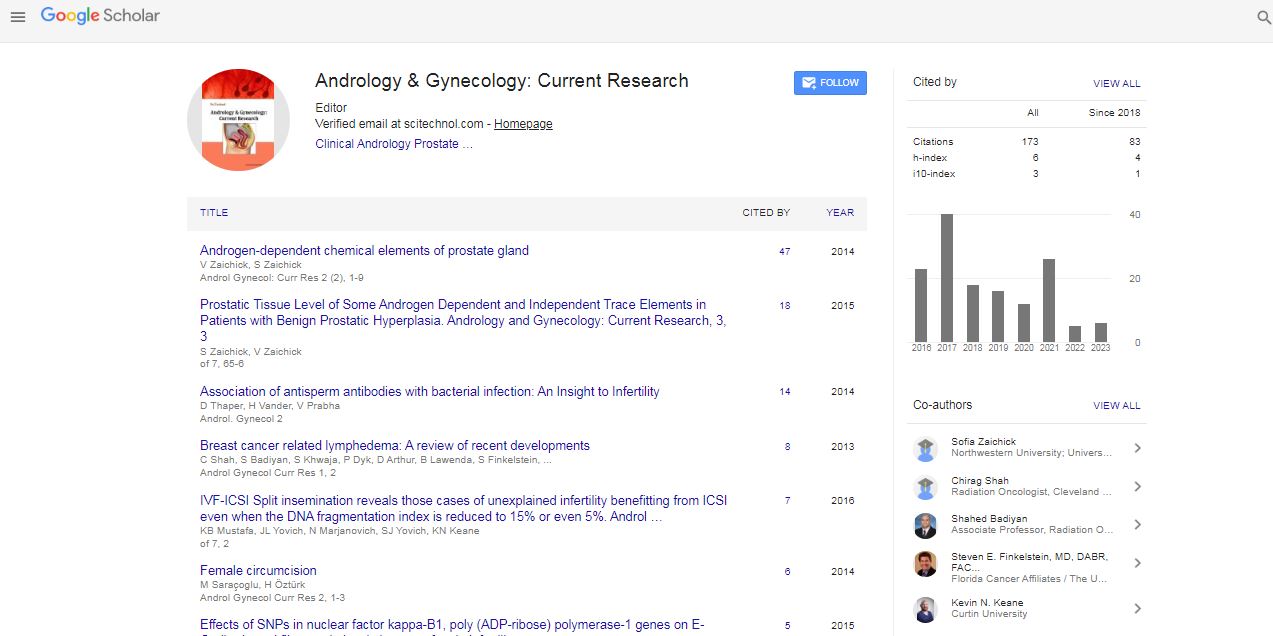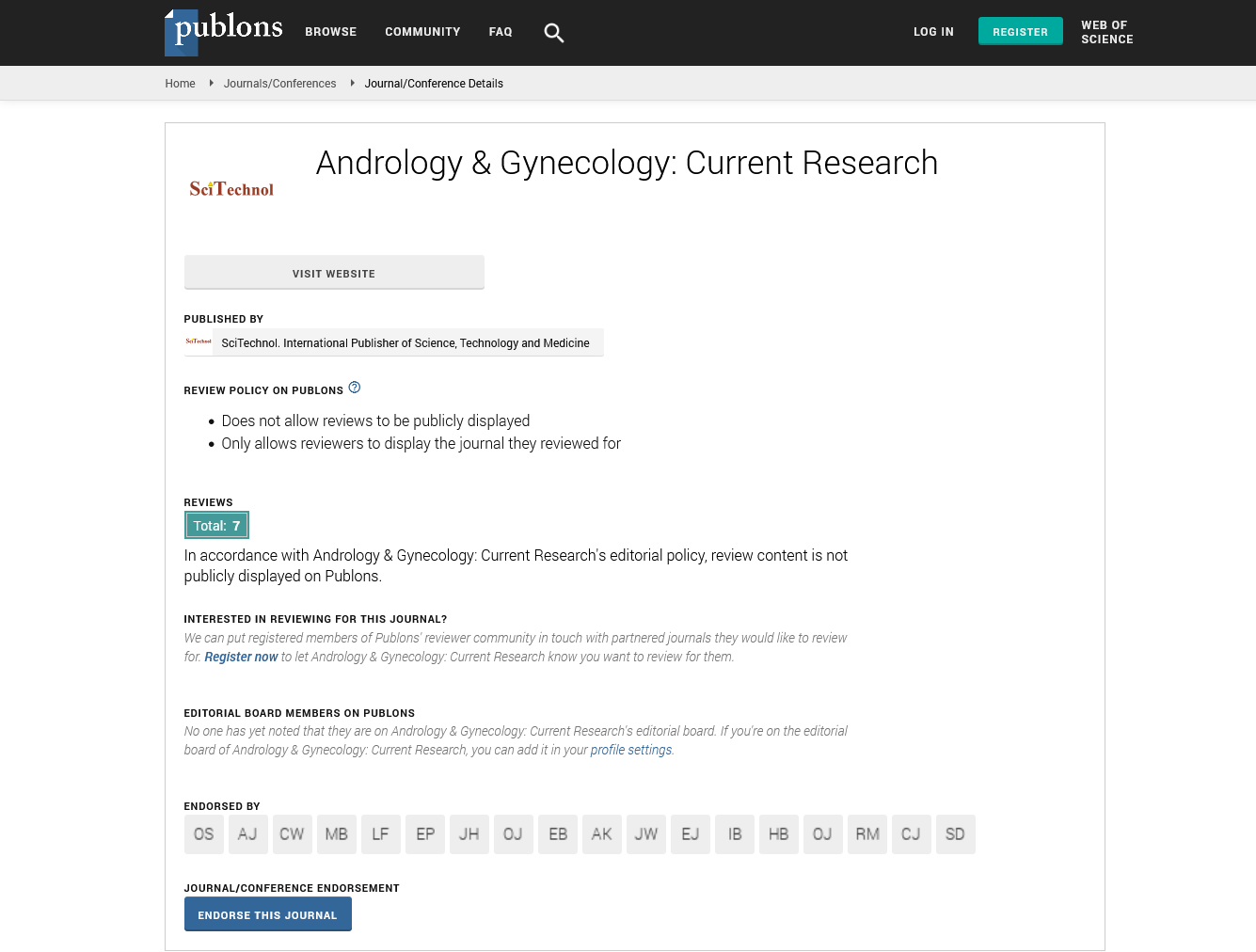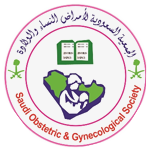Editorial, Androl Gynecol Curr Res Vol: 1 Issue: 1
The Expression of Genes in Human Ovarian Granulosa Cells during Assisted Reproduction Technologies and their Clinical Significance
| Michail Varras* |
| Third Department of Obstetrics and Gynecology, “Elena Venizelou” General Maternity State Hospital, Athens, Greece |
| Corresponding author : Dr. Michail Varras, MD, MSc, PhD Third Department of Obstetrics and Gynecology, “Elena Venizelou” General Maternity State Hospital, Athens, Greece E-mail: mnvarras@otenet.gr; mvarras@otenet.gr |
| Received: October 19, 2012 Accepted: October 22, 2012 Published: October 24, 2012 |
| Citation: Varras M (2012) The Expression of Genes in Human Ovarian Granulosa Cells during Assisted Reproduction Technologies and their Clinical Significance. Androl Gynecol: Curr Res 1:1. doi: 10.4172/2327-4360.1000e102 |
Abstract
The Expression of Genes in Human Ovarian Granulosa Cells during Assisted Reproduction Technologies and their Clinical Significance
Pre-ovulatory follicles contain two distinct types of granulosa cells which are the mural granulosa cells and the cumulus cells. At present, there are no morphological or physiological features of oocytes that can predict whether IVF fertilization will be successful, or whether is a need for ICSI unrelated to male factor infertility..
Keywords: Apoptosis; Survival; Survivin; Granulosa cells; IVF; ICSI; Gene expression
Keywords |
|
| Apoptosis; Survival; Survivin; Granulosa cells; IVF; ICSI; Gene expression | |
Abbreviations |
|
| IVF: In vitro Fertilization; ICSI: Intra Cytoplasmic Sperm Injection; hCG: Human Chorionic Gonadotropin; ET: Embryo Transfer; FSH: Follicle-Stimulating Hormone; LH: Luteinizing Hormone; GnRH: Gonadotropin Releasing Hormone; ART: Assisted Reproductive Technology; GDF9: Growth Differentiation Factor 9; TGF-b: Transforming Growth Factor-b; HAS2: Hyaluronic Acid Synthase 2; GREM1: Gremlin1; AMH: Anti-Mullerian Hormone; rFSH: Recombinant FSH; FSHR: Follicle-Stimulating Hormone Receptor; EGF: Epidermal Growth Factor; bFGF: Basic Fibroblast Growth Factor; IGF: Insulin Growth Factor | |
| The adult human ovary is composed of various cell types. Preovulatory follicles contain two distinct types of granulosa cells that arise during folliculogenesis as the cell populations segregate upon formation of the fluid-filled follicular antrum. The mural granulosa cells line the follicle wall and reside very close to the basement membrane and are essential for oestrogen production and follicular rupture. The cumulus cells are closely connected to the oocyte through a gap junction network and are associated with the oocyte development [1,2]. A cascade of events drives ovulation, initiated upon receipt by the follicle of the preovulatory LH surge inducing breakage of the intercellular connections between oocyte and cumulus cells and changes in the expression of genes in theca and granulosa cells and oocyte as well [2]. | |
| At present, there are no morphological or physiological features of oocytes that can predict whether IVF fertilization will be successful, or whether is a need for ICSI unrelated to male factor infertility. Disadvantages for the general use of ICSI is the fact that this procedure is a time-consuming technique compared to IVF and requires special equipment and skills. Also, the cost of ICSI is deterrent, while an increase in the risk of transmitting chromosomal anomalies or imprinting disorders has been described, although it is not clear whether these risks are due to the procedure or to the factors causing male infertility [3-9]. In view of concept of the beneficial effect of granulosa cells on oocyte maturation and the need for independent prognostic markers of better outcomes with conventional IVF for couples with non-male factor infertility, studies were focused on target genes in luteinized granulosa cells of the human ovaries. | |
| A need for more accurate embryo selection in human assisted reproduction is needed to optimize and reduce the number of embryos transferred into the uterus in order to achieve the best balance between reducing the risk of multiple gestations and maximizing the probability of pregnancy. Current selection methods are based mainly on morphological and developmental criteria and include the speed of cell division (number of blastomeres at any given stage of development), the regularity of cell division and the degree of fragmentation. Moreover, in some countries, not all retrieved oocytes can be fertilized due to legal limitations. An example is Italy where its legislation allows only three oocytes for each patient to be fertilized. In such situations, predicting embryo quality is even more challenging because the time when the predictive evaluation can be performed is limited to the interval between oocyte retrieval and fertilization. This has prompted the search for additional parameters that can support morphological and metabolic evaluations of the oocyte in order to appropriately select those that have the greater chance of fertilization and development. In this respect, the analysis of granulosa cells is a good approach for providing such supplementary information [10,11]. | |
| Growth differentiation factor 9 (GDF9), is a member of the transforming growth factor-b (TGF-b) super-family. Huang et al. [12] investigated the role of GDF-9 in human follicular development by quantifying intra-follicular granulosa cell GDF-9 expression and explored the relationship of its expression with the efficacy of ovulation induction and in vitro fertilization (IVF) outcomes; the authors found a statistically significant correlation between GDF-9 concentration and the number of dominant follicles (≥16 mm) on the day of hCG (human chorionic gonadotropin) administration suggesting that the levels of GDF-9 mRNA may be associated with FSH-dependent follicle maturation in IVF embryo transfer programs [12]. Cilo et al. found that the levels of HAS2 (hyaluronic acid synthase 2) and GREM1 (gremlin1) mRNA expression was greater in cumulus cells isolated from oocytes that developed into high-quality embryos than that of cumulus cells isolated both from oocytes developing into poor-quality embryos, and from those that failed to be fertilized [10]. The expression of FSHR has been suggested to have a clinical significance in assisted reproduction programs. Cai et al. found that the expression of FSHR in granulosa cells was lower in women with a poor response to gonadotropin stimulation compared with moderate and high responders and that increasing the dose of rFSH could not improve ovarian response, suggesting that the variability of FSHR necessarily may determine ovarian response to gonadotropin stimulation [13]. | |
| Apoptosis is the programmed cell death and is genetically determined. It plays an important role in several physiological events, such as follicular atresia, luteolysis and placentation and in several pathological conditions. Gonadotropins and estrogens prevent granulosa cells apoptosis, whereas androgens enhance granulosa cells death by apoptosis [14]. Apoptosis or survival of follicles dependent on autocrine and paracrine signals from theca cells, granulosa cells and oocyte. Follicular apoptotic factors include caspases, protein bax, member of the tumor necrosis factor family (TNF-alpha, Fas, FasL, TRAIL), tumor suppressor protein P53, members of the transforming growth factor-beta family (factor NODAL, and AMH), c-Myc, endothelins, androgens and GnRH. Successful follicular development depends on the presence of survival factors that promote follicular growth and also protect cells from apoptosis. These include factors produced within the ovary as well as the gonadotropins LH and FSH. Some of the paracrine factors that promote survival during the growth and differentiation of follicles include kinase Akt, member of the bcl-2 family, KIT-ligand and c-KIT receptors, stem cell factor (SCF), member of the TGF-beta family (activin factors BMP-4 and BMP-7, growth differentiation factor-9), oestrogens, insulin and IGFs, epidermal growth factor (EGF), basic fibroblast growth factor (bFGF), TGF-alpha, interleukin 1b (IL-1b), growth hormone (GH) and survivin. Most of the inhibitors of follicular atresia are regulated by FSH and LH [15]. Apoptosis of granulosa cells seems to have a negative effect on IVF outcomes. A higher incidence of apoptotic granulosa cells has been associated with a higher incidence of empty follicles, fewer oocytes retrieved, poor quality of oocytes and embryo development and poor fertilization [16-19]. Nakahara et al. suggested that when the quality of eggs is small, measured by apoptosis in granulosa cells, then the eggs are more likely to be fertilized by ICSI compared with IVF method [16]. However, Clavero et al. found that the rate of apoptosis in granulosa cells was not associated with the maturity of the oocyte and the ability for fertilization in ICSI or the quality of follicles during ovulation induction [20]. Despite the controversy that exists in the literature about the effects of apoptosis in luteinized granulosa cells as predictor of oocytes quality during ovulation induction in cycles of IVF or ICSI, the estimation of survival factors for prognosis provides the IGFs family, because IGF1, IGF2 and their receptors are down regulated in ovarian granulosa cells of women with diminished ovarian reserve (DOR) compared to those with normal ovarian reserve (NOR) undergoing in vitro fertilization (IVF) [21]. In addition, it has been found that survivin could play an important role in granulosa cells, acting as a functional protein associated with regulation of the cell cycle and inhibition of apoptosis [22]. Fujino et al. studied the expression of survivin gene in granulosa cells from infertile Japanese patients and found such expression in all granulosa cells. In addition, we studied the expression of survivin gene expression in granulosa cells from Greek infertile patients who underwent IVF or ICSI and found such expression in 93% [23]. Fujino et al. found that the gene expression levels of survivin in patients with endometriosis were significant lower than in patients with male factor infertility. The gene expression levels of survivin in total pregnant patients were higher than those in total nonpregnant patients and those in the male factor infertility [23]. In our study, we found a statistically significant increased expression of survivin in granulosa cells of women who had tubal factor infertility compared with normal women (male factor infertility). In our study only normal women (male factor infertility) and women with tubal factor infertility were studied [15]. Women with endometriosis were not included since endometriosis promotes apoptosis [16] and also women with polycystic ovarian syndrome because androgens promote apoptosis as well [14]. Therefore, it seems that survivin acts a protective role in the ovarian micro-environment. It is possible that survivin might try to protect ovaries, with possible influenced perfusion due to ipsilateral salpingectomy. In cases with tubal inflammation or hydrosalpinges survivin might try to protect the ovaries from follicular apoptosis in a paracrine environment [15]. We enounce our hypothesis about the levels of survivin mRNA expression in ovarian granulosa cells in tubal factor infertility. Some patients in the subpopulation of women with tubal factor undergoing assisted reproduction and embryo transfer probably could benefit in assessing oocyte quality by measuring the levels of survivin expression in their granulosa cells. Therefore, if the survivin levels in granulosa cells are low, then ICSI should be concerned, as ICSI is an invasive method and good oocyte quality is not required. On the other hand, if survivin levels are highly expressed in granulosa cells then IVF should be preferred, as IVF is a non-invasive method and therefore normal sperm-egg interaction and good oocyte quality is essential [15]. | |
References |
|
|
 Spanish
Spanish  Chinese
Chinese  Russian
Russian  German
German  French
French  Japanese
Japanese  Portuguese
Portuguese  Hindi
Hindi 


